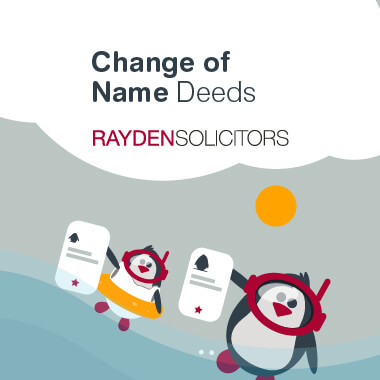

What is a Change of Name Deed?
A Change of Name Deed is a formal notice of intent to change a name from a previous one. There are two types of Deed – enrolled and unenrolled. The difference between an enrolled Deed and an unenrolled Deed can be made public and this means that an announcement will appear in the London Gazette.
The most important step is choosing your new name carefully as this will be the legal name you are known by going forward. It is important to remember that the name you choose is an integral part of your identity.
By and large there are no restrictions as to what you can call yourself but there are some limits and these are:
- Names that are impossible to pronounce
- Names that include numbers or symbols
- Names that are vulgar or offensive
- Names that do not include at least one forename and surname.
A Deed Poll is a legal document and is proof of your change of name. It is not proof of identity on its own but is evidence of identity in conjunction with other documents such as your driving licence and passport.
It is also important to remember that your passport will remain a valid document until you change it and you can still travel with it but if you do you must ensure that all travel documents e.g. visas, tickets, hotel bookings etc. are all in the same name to ensure that this does not cause problems with travelling and through border control.
Why change your name?
There are many reasons for changing a name and these are just a few examples:
- Marriage or divorce;
- In the case of children – adopting mother or father’s surname;
- If your name is often mis-pronounced or mis-spelt;
- Couples creating new joint surname by merging and hyphenating names;
- In families where there are step-children, to give all children of the family a uniform identity and stablise the family;
- Gender reassignment;
- Means of self-protection for example in the case of domestic abuse;
- In memory of a loved one say by adopting a middle name; and
- To add or remove a middle name.
You can change your name more than once, there are no restrictions but it is important to choose the name you are comfortable with as your Deed Poll should be seen as a permanent change.
Can you change your child’s name?
You can change your child’s name and it can be a relatively straightforward process providing that all parties with parental responsibility agree and consent to the change. This agreement does not have to be in writing but it is helpful if it is and this is why at Rayden Solicitors we provide a letter of consent for all parties to sign.
In the event that one party does not agree to the change, it is still possible but an application can be made to the court for a specific issue order for permission for the change of name.
The court will take everything into account and most importantly what is in the best interest for the child. If a Deed is obtained and executed without consent then it is possible for the party who has not consented to apply to the court to have the change reversed.
A child who is aged 16 or over can apply and execute their own Deed as an adult. The only exception to this is if they are subject to children proceedings through the court and they will therefore need to wait until they are 18.
How can Rayden Solicitors help with your Change of Name Deed?
Rayden Solicitors can assist with the whole process of changing your name or your child’s name.
We will prepare the document for you and the necessary consent documents. It is a simple process and will only require one visit to any of our offices to sign the document. We will also provide a number of certified copies for your use.
We provide a handy checklist of who to inform once your Deed is finalised. There is a lot to think about and it can be a little overwhelming but it is hoped that this checklist will make the process easier!
In the case of any dispute surrounding changing a child’s name, we can provide advice on this and making an application through the court and guide you through the whole process to include completing the application and submitting this to the court.
Change of Name Deed FAQs
How long will it take for the Change of Name Deed to process?
Once you have made that decision to change your name it is a relatively simple process. Once we have taken your instructions the Deed will then be prepared and at that stage you will need to attend the office. We have a number of offices and you can choose where you would like to attend and the Deed would be finalised at that appointment. This can all be done within a couple of days of taking instructions.
What happens once I have my Deed?
Once the Deed is finalised then all organisations and authorities will need to be notified of the change. Generally it as advisable to change your driving licence and passport first as these as mostly used as evidence of your identity. The DVLA can check your identity directly with the Passport Office and this would negate the need to send your Deed in the post to update your driving licence if you change your passport first. Some organisations will require to see the original Deed, it is definitely worth checking first if you need to do this as this will slow the whole process down. We will provide you with a number of certified copies and this should assist. Further certified copies are also available if required.
This can be a daunting and time consuming exercise as all official record holders and authorities must be informed and this is why we also provide the checklist to guide you through.
How much does it cost?
For a straightforward unenrolled Deed Poll this is charged at a single fixed fee which is available on request.
For more complex documents that may include a court application please contact our team for further information and advice.
Speak to us
If you would like to arrange a first meeting or have any questions, please contact us or fill in the enquiry form below.











